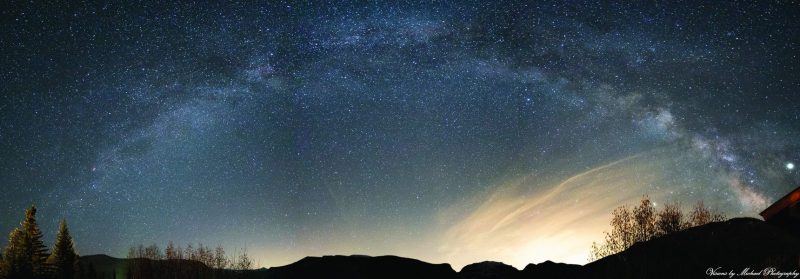

View at EarthSky Community Photos. | Marc Toso of the website Ancient Skys captured this seven-frame panorama around 1 a.m. on May 5, 2019.
Although we can’t see the Milky Way in early evening now, we can see it around midnight or later. Marc Toso wrote:
I drove out into the center of Nevada hoping to catch a glimpse of the Eta Aquarid meteor shower, the dust of the famous Halley’s Comet. I failed to catch any meteors with my camera but instead found a massive crater. Not a meteor crater, but a volcanic crater called Lunar Crater. Interestingly, this landscape was used to train Apollo astronauts in 1972.
The airglow was strong that night, as seen by the red and green smeared across the sky. And skies were clear, the planet Jupiter can be seen on the right, riding the Dark Horse Nebula.
Another interesting note, the glow behind the hill on the right is light pollution from Las Vegas, 163 miles [262 km] away as the crow flies!
Thank you, Marc. By the way, we received a second photo very similar to Marc’s, taken a day earlier and several hours later by the clock, over a different landscape. See it below.

View at EarthSky Community Photos. | The Milky Way over Grand Lake, Colorado, by Michael Davis. He captured the images to create this panorama on May 4, 2019, around 3:30 a.m. One sky! Thank you, Michael!
Bottom line: The starry arc of the Milky Way over a volcanic crater – Lunar Crater – in Nevada. Plus the Milky Way over a mountain silhouette in Colorado.
from EarthSky http://bit.ly/2PXMFIa


View at EarthSky Community Photos. | Marc Toso of the website Ancient Skys captured this seven-frame panorama around 1 a.m. on May 5, 2019.
Although we can’t see the Milky Way in early evening now, we can see it around midnight or later. Marc Toso wrote:
I drove out into the center of Nevada hoping to catch a glimpse of the Eta Aquarid meteor shower, the dust of the famous Halley’s Comet. I failed to catch any meteors with my camera but instead found a massive crater. Not a meteor crater, but a volcanic crater called Lunar Crater. Interestingly, this landscape was used to train Apollo astronauts in 1972.
The airglow was strong that night, as seen by the red and green smeared across the sky. And skies were clear, the planet Jupiter can be seen on the right, riding the Dark Horse Nebula.
Another interesting note, the glow behind the hill on the right is light pollution from Las Vegas, 163 miles [262 km] away as the crow flies!
Thank you, Marc. By the way, we received a second photo very similar to Marc’s, taken a day earlier and several hours later by the clock, over a different landscape. See it below.

View at EarthSky Community Photos. | The Milky Way over Grand Lake, Colorado, by Michael Davis. He captured the images to create this panorama on May 4, 2019, around 3:30 a.m. One sky! Thank you, Michael!
Bottom line: The starry arc of the Milky Way over a volcanic crater – Lunar Crater – in Nevada. Plus the Milky Way over a mountain silhouette in Colorado.
from EarthSky http://bit.ly/2PXMFIa

Aucun commentaire:
Enregistrer un commentaire